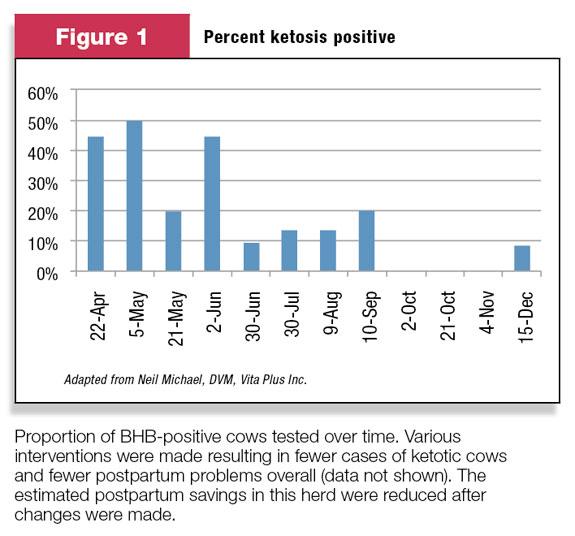What level of ketones defines ketosis? Defining an exact level at which ketones are too high has been something of an enigma. Ketosis is a threshold disease, meaning cows will be affected only after a certain level has been reached. The mean level of ketone bodies for a population of animals in a herd means little. Furthermore, because some of the manifestations of ketosis occur later, it is more difficult to study. Most research studies are based on blood betahydroxybutyrate (BHB), which is considered the “gold standard” in testing.
In a large Northeast study that evaluated milk production, reproductive performance and disease outcomes, the critical threshold of BHB was determined to be greater than 1,000 µmol per L when measured three to 14 days after calving.
In yet another study, cows with BHB greater than 1,000 µmol per L in the first week postpartum were 25 times more likely to have a displaced abomasums (DAs).
Based on work in literature thus far, one can conclude that BHB levels greater than 1,200 µmol (1.2 mmol or ~12.5 mg per dl) are not normal and cows with this level or above should be considered ketotic, a conclusion supported recently by Canadian researchers.
How is ketosis measured?
Ketosis can be measured by several different methods including blood, urine and milk. As noted, blood BHB level is considered the “gold standard” for ketosis testing, but until recently has been relatively expensive and time-consuming, requiring samples to be sent to a commercial lab with a subsequent wait for results.
In the past few years, a cowside blood test has become available, using the Precision Xtra. This device is a pocket-sized glucose meter that can also test BHB, using the BHB strip available at many drugstores and from veterinary distributors.
Dr. Gary Oetzel at the University of Wisconsin, who has been using the device for his herd investigation work, has validated the device with blood BHB compared to a commercial lab. German workers have also validated the device.
In both studies, its performance was excellent compared to the commercial labs (sensitivities and specificities above 95 percent respectively). The Precision Xtra test requires a small amount of blood, usually drawn from the tail vein using a small syringe and needle.
Test strips for urine and milk offer an alternative to collecting blood. Urine strips have demonstrated relatively good performance in some studies. The difficulty, of course, lies in the collection of urine. Cows simply do not provide urine on demand, making the urine test more time-consuming than collecting milk or blood.
A milk powder test has been available in the U.S. for some time. This test procedure requires mixing a half-teaspoon of test powder in a small amount of milk, and waiting two minutes for a color change. This tests for acetoacetate, not BHB, and the sensitivity of this test has proven to be relatively poor, resulting in a missed diagnosis of more than half the tested cows that actually have ketosis.
Recently, we made a cowside strip test available in the United States, after its many years of use in Canada. It is a semiquantitative colorimetric, milk test strip that measures BHB in milk from 0 to 1,000 µmol per L. The concentration of BHB in milk is considerably lower than BHB levels in blood.
It has been evaluated in several studies and has been found to offer relatively good sensitivity and specificity, making the test useful for both diagnostic and herd-monitoring applications, and an effective choice for ketosis testing when milk samples are to be used.
When should ketosis testing be done?
There are two broad categories of ketosis testing; one is to examine an individual cow or cows, usually in conjunction with a fresh cow examination protocol, and the other is to use ketosis testing as a herd-monitoring tool.
With the individual cow program, the cow has already been identified as abnormal based on her feed intake, temperature or some other clinical sign or signs. The ketosis testing is then run as a diagnostic aid. Individual cow testing is typically done on a cow-to-cow basis and a single cow may be tested multiple days in a row.
In herd-based monitoring, the goal is to determine whether the herd has an underlying problem that warrants further investigation. Cows in the herd that are less than 50 days in milk and otherwise normal are tested, with testing done as needed once every two to three weeks on different populations of cows.
How should the results of testing be interpreted?
When a dairy is testing individual cows, the outcome will frequently be used to determine whether or not that cow is going to be treated for ketosis. In many herds, the cow in question is going to be treated regardless of the outcome.
When the test is positive, the dairy will often declare ketosis as the underlying problem with that cow and move on. In this instance, caution should be exercised because of the correlation of ketosis and DA and ketosis and metritis. Cows in this scenario should be examined carefully for the next several days.
In herd-based testing, the results are based on the proportion of animals declared positive, and the sample size needs to be considered. Using an alarm level of 10 percent positive cows, the appropriate sample size to achieve 75 percent confidence in the declaration is at least 12 cows.
Larger herds can do this all at once (testing cows three to 21 days in milk), and smaller herds may require multiple tests over time.
Using our cowside strip test in the parlor, a larger herd can test 15 to 20 cows in the fresh pen in one or two turns of the parlor every two or three weeks. In herd-based testing, the test should be administered on otherwise normal animals that have not had problems with DAs, metritis, etc.

In an interesting example of herd-based testing, Dr. Neil Michael of Vita Plus Inc. used BHB as one of the metrics to evaluate how various changes in a dairy operation could affect overall postpartum costs. Figure 1 shows the BHB results from one such dairy.
*Figure notes*: Proportion of BHB-positive cows tested over time. Various interventions were made resulting in fewer cases of ketotic cows and fewer postpartum problems overall (data not shown). The estimated postpartum savings in this herd were reduced after changes were made.
This dairy initially had a high percentage (greater than 20 percent) of tested cows showing positive results for ketosis. Various changes were made, resulting in a reduction of cows testing positive (less than 10 percent).
This example illustrates that a goal of less than 10 percent of cows testing positive is obtainable. Note that the testing interval was lengthened in this herd based on the good results. It is important to realize that not all interventions need be nutritionally related and that a high percentage of ketosis does not mean the nutrition program is at fault.
Improving cow comfort and decreasing the time spent in the dry period (which may reduce overcrowding of the facility) are examples of two non-nutritional changes that might impact ketosis. Reducing the costs of getting a cow through the postpartum period can mean more profit to a dairy and, in this example, BHB monitoring was one of the tools used to do just that.
When using the milk BHB strip to test an individual animal to determine treatment, the 200 µmol per L or 2 mg per dl cut point rather than the 100 µmol per L is recommended to minimize the number of false positives. From an economic standpoint, it has not been determined what ketosis level warrants intervention.
How should ketosis be treated?
This is a difficult question, because while we know that undesirable ramifications can occur due to ketosis, we do not yet know the exact level at which intervention should occur. Fortunately, treatments for ketosis are not very costly and the risk of side effects from treatment is low.
Thus, if you do treat an animal deemed ketotic by one of the tests above and she is not really ketotic, the cost to the dairy includes the cost of treatment and cost of labor. The bigger question is whether there is any benefit in treating cows that truly are ketotic, and at what level does that benefit occur?
Clinical experience tells us that if the cow is exhibiting signs of ketosis and a diagnosis of such has been made with one of the tests, treatment is usually beneficial, provided the cow does not also have a DA or ketosis associated with fatty liver.
An individual farm should consult with its veterinarian on the best method for treating individual cows. In herd-based monitoring, it is strongly advised that the dairy notify both the nutritionist and veterinarian of the test results to help manage the situation.
When more than 10 to 20 percent of routinely monitored cows have positive results repeatedly, research has shown there is an economic cost to that dairy and intervention is warranted.
How much does ketosis cost a dairy?
The cost of ketosis is difficult to quantify because many factors must be considered. Ketosis impacts other metabolic conditions like DA and metritis, can affect the herd’s reproductive performance and milk production and can even impact a cow’s immune system, all making the true cost of the condition extremely difficult and variable to assess.
In a recent dairy publication, the cost of ketosis based on Cornell University research was estimated to be $13,000 for every 100 cows. Some older work estimated the cost to be about $97 per case in today’s dollars, but that was estimating only the cost of subclinical cases.
The takeaway message is that there is an economic impact of ketosis on the dairy, which means a dairy should have a knowledgeable response to the question: Are your cows ketotic? PD
References omitted due to space but are available upon request to editor@progressivedairy.com .

Dave Prentice
Veterinarian
Elanco Animal Health
dlpdvm@alpinecom.net








